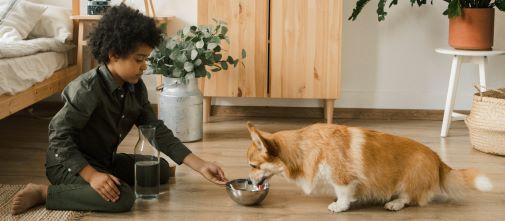
When it comes to caring for our pets, we often think about their food, exercise, and overall well-being. But there's one vital aspect of pet care that sometimes gets overlooked – ensuring they have access to clean, fresh water. Learn the significance of fresh water in your pet's life, including how often to clean their water bowl, the proper way to do it, and the best types of bowls for your pets.
Why Fresh Water Matters
- Hydration and Health: Just like humans, pets require a constant supply of fresh water to stay healthy. Water is essential for various bodily functions, including digestion, temperature regulation, and the elimination of waste products. Dehydration can lead to a range of health issues, so providing clean, fresh water is crucial for your pet's overall well-being.
- Preventing Illness: Stagnant water can become a breeding ground for harmful bacteria, algae, and other contaminants. When your pet drinks from a dirty bowl, they are at risk of ingesting these harmful substances, which can lead to illness. Keeping their water clean and fresh helps to reduce the likelihood of waterborne diseases.
How Often to Clean Your Pet's Water Bowl
To ensure that your pet has access to clean water, you should clean their water bowl regularly. Here's a general guideline for different types of bowls:
- Daily Cleaning: it's advisable to clean your pet's water bowl thoroughly every day, especially if you use a plastic or ceramic water bowl. This ensures that bacteria and residue don't accumulate, providing your pet with a consistent source of fresh water.
- Stainless Steel Bowls: Stainless steel bowls are a popular choice due to their durability and resistance to bacterial growth. While they may not be as susceptible to bacteria, it's a good practice is to wash them daily
- Automatic Water Dispensers: These are convenient, but they can be a breeding ground for bacteria if not cleaned regularly. Check the manufacturer's recommendations for cleaning frequency.
How to Clean Your Pet's Water Bowl
Cleaning your pet's water bowl is a straightforward process. If you don't have a dish washer or a dish washer safe bowl, here's a step-by-step guide:
- Empty the Bowl: Start by emptying any remaining water from the bowl.
- Wash with Mild Soap: Use a mild, pet-safe soap and warm water to wash the bowl. Avoid harsh chemicals or detergents that could leave residues or harm your pet.
- Scrub Thoroughly: Use a soft brush or sponge to scrub the bowl, paying special attention to any stubborn residues or stains.
- Rinse Well: Rinse the bowl thoroughly with clean water to remove all soap residues.
- Dry Completely: Ensure the bowl is completely dry before refilling it with fresh water. Damp bowls can attract bacteria.
The Best Types of Bowls for Your Pets
- Stainless Steel: Stainless steel bowls are a top choice due to their durability and resistance to bacterial growth. They are also less likely to retain odors and stains.
- Ceramic: Ceramic bowls are heavy and less likely to tip over, making them suitable for larger pets. Just be sure to choose one that is lead-free and easy to clean.
- Plastic: While plastic bowls are affordable, they can develop scratches and crevices where bacteria can hide. If you opt for plastic, make sure to replace it regularly and clean it thoroughly every day.
- Automatic Water Dispensers: These are excellent for providing a continuous supply of fresh water, but they require regular cleaning to prevent bacterial growth.

Comments (0)
Back to Blog